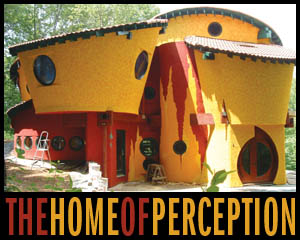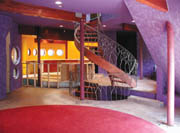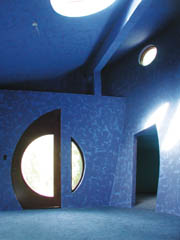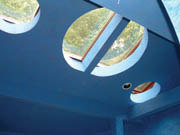

Villa Vuoto is Matthew Schlueb's concept for designing an environment for his young son, Oskar. The home is a hybrid of eastern philosophy, Italian heritage and the family's ties to Pittsburgh. These three factors, in theory, will contribute to Oskar's spatial cognitive development "outside the box."
"The goal was to create a house that would stimulate my son's whole development process in his younger formative years," Schlueb, president of Schlueb Architecture, says. "I feel architecture has that potential on younger kids or people, in their formative years. If they're exposed to the right types of stimuli, it can actually enhance their development or cognitive skills."

East, west
The eastern influence comes from how homes are built in Asia and other areas where the floorplan is open. Villa Vuoto doesn't have isolated, traditional boxed rooms but space that flows from one area into the next, winding from the bottom on up. (Also, Schlueb's wife Julianne studied in the east and taught English there.)The Italian heritage is linked also to Julianne, whose ancestry comes from the land of DaVinci, Machiavelli and Moretti. The home's interior and exterior walls have plaster and (Old World style) stucco, respectively.
The third factor is Pittsburgh-in particular, southwestern Pennsylvania-that also contributes to the home's look. The circular floorplan of the home is a reference to the Adena wigwam, with its outward-leaning walls.
"I believe that when these building forms ... deeply rooted in circular form are used in the design of the house, it creates a subtle yet powerful connection to the natural world-and more specifically to the southwestern Pennsylvania region," says Schlueb. "This similarity establishes for Oskar a connection to his past, in addition to an opportunity to learn lessons from these ancient people. He will learn firsthand what it is like to live in circular space, paralleling the circular movements within nature, thereby developing a deeper understanding of his environment. Ultimately, he could acquire a greater sensitivity to his immediate environment, which would be in stark contrast to most of today's homes that serve to insulate their children from the outside world."

Meshes of the afternoon
Because of the unit's bizarre structure, Schlueb built a model to help people visualize the concept instead of handing out blueprints. This came in handy, as subcontractors that came to bid on the project either stepped up to the challenge or voluntarily declined after they saw a micro version of Villa Vuoto."You got the subs that were very enthusiastic about it and liked the challenge of something different from their typical job, and wanted to really put out their best work to show off," Schlueb says. "And then you got the other subs that didn't want the challenge, so it made the selection process very easy."
The project broke ground in August 2002 and as of press time, a few last minor details should fold the project by the holiday season. The home's interior, with its open floorplan, contains three bedrooms, two-and-one-half baths, kitchen, living area-the typical quarters found in any home. During the construction though, each individual trade found something unique to the construction process and the home found delays in the production schedule.
Because of the home's conical shapes, the extensive use of radius tracks had to be set throughout the home. The Flex-C system from Flex-Ability Concepts was used for its traditional use of wall systems but also to frame around doors, windows, coves and built-ins. Approximately 1,700 linear feet of the system was used for the project.
"The roofs are shed roofs; however, since they are circular in plan we had a hard time using a typical roofing detail to trim out the perimeters," says Schlueb. "So, we actually used a track up there as well to run it along the perimeter to give us something to fasten our roof shingles to."
Because the track is dimensionally 11⁄4 inches in height, it was able to be used as a leveling point around the perimeter of the walls since the floorplan was convoluted. The system was shaped to the walls and the floor where there are divisions in floor material, such as carpet to concrete, and used to cast concrete against as a form work.
And because of the "convoluted" walls, most drywall hangers/plasterers would double up on 11⁄4-inch board. The plastering, stucco, EIFS and finishing contractor for the job was Steel City Plastering Inc., of Cheswick, Pa., whose Harry Stites Sr. suggested that they could manipulate a single layer of National Gypsum's Kal Kore 1/2-inch blue board to prepare for the plaster. Each piece had to be soaked and then scored to fit the contours of the wall. In some places where the board wouldn't fit, they used metal lath, or in various spots would piece both the board and lath together.
"The way the walls just disappeared in corners, there are no straight angles inside of this house, there are no light ceilings, all the finishes are tinted and we used an interior stucco finish on the inside," says Stites.
Looking from the inside out
On the outside of the home, traditional one coat stucco was used with some EIFS in certain areas. The stucco was mostly used because the home bends and curves so frequently, it would have been highly complex to manipulate the foam of the EIFS system.
"I was worried about getting growth on the exterior or running into moisture problems," says Schlueb. "The shape of the house also drove how we applied it (the stucco and EIFS) because what we found is that on the walls that are conical in shape, where they're sloping in or out on the circle, we couldn't get the foam to lay flat on the walls. What we did was put down a wire lath and did a more traditional approach to the stucco application. On the other walls, where we had flat surfaces, we were able to get the foam to go down. So, it's kind of a hybrid of the two (EIFS and one coat stucco). But the final coat over the entire house is an acrylic coating from Senergy called Senerflex Textured Finish."
Schlueb and Stites both cite Exterior Products, of Pittsburgh, and its president, Rich Haarbauer, for working so closely with the project and providing all the stucco and EIFS material. In addition to being the distributor for the project, Exterior Products also provides custom tinting to the products it sells.
"We could've done these textures and painted them, which would've been a typical southern application," says Haarbauer. "But instead, we used very flexible acrylic finishes in multiple colors to achieve the texture and look, which also have the ability to bridge hairline cracks. It also gave the owner the advantage of having the finish being colored through the whole layer of finish vs. it just being painted."
The home has garnered both local and national attention. The home has been featured in the Pittsburgh Post Gazette and was awarded the 2004 National One Coat Stucco Association's Design Awards Program for best Residential project. Many neighbors still make a point to take evening walks with the dog to come check it out; some architects have called to arrange "walk-throughs," which Schlueb has welcomed.


Report Abusive Comment